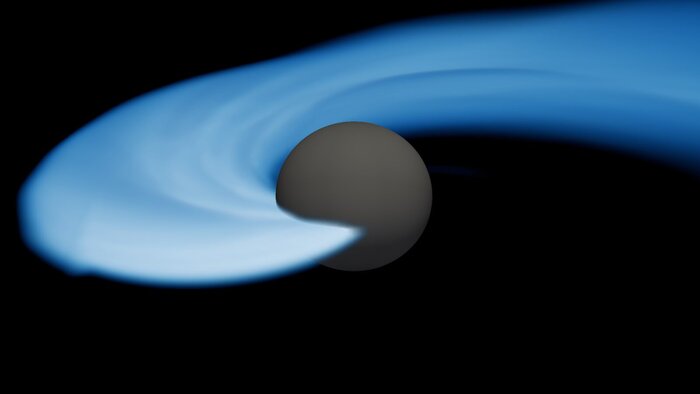Designated by a vulgar number, "2MASS 19281982-2640123" is not the biggest "star" of the celestial vault.
Far from there.
Far from us too, moreover, since this star which today emerges from anonymity is located 1801 light-years away, that is to say that its light takes more than 18 centuries to reach us.
As nothing travels faster than light, anything escaping from this celestial body to reach us would, in theory, take at least as much time to complete the journey.
Including a message written by an intelligent life form?
This is a scenario in which Alberto Caballero wants to believe.
For a year and a half, this amateur astronomer has been claiming that the discreet star in the constellation Sagittarius is the most likely source of a radio signal recorded 45 years ago by an American telescope, of which it is not excluded that it was emitted by an extraterrestrial civilization.
After peer review, his work finally appears this month in the very serious journal International Journal of Astrobiology, published by the publishing house of the prestigious University of Cambridge, United Kingdom.
He explains why "2MASS 19281982-2640123" may hold the key to a long enigma.
An unusual sequence
On August 15, 1977, an Ohio University radio telescope nicknamed “Big Ear” picked up a high-intensity signal for 72 seconds, thirty times higher than the background noise of the universe. .
The strange phenomenon is only discovered a few days later, when a technician brings readings to the home of Jerry Ehman, a volunteer for this SETI project (“search for extraterrestrial intelligence” or, in French, “research for extraterrestrial intelligence” ).
Browsing through the printouts, the 30-something sees a very unusual alphanumeric sequence.
In the middle of the "1" and "2", which indicate standard levels, appear letters, which means that the radio waves perceived are at least ten times more intense than normal.
Flabbergasted, Ehman circles this suite “6EQUJ5” in red pen and comments on it in the margin: “Wow!
A testimony of surprise (similar to our “Wow!”) that gave its name to a signal that has become famous.
No natural phenomenon corresponds
What is it about ?
Forty-five years later, the mystery remains.
The days, then the years, which follow the discovery, astronomers probe the region of the sky from which the signal would have come in search of a repetition.
In vain.
In 2020, several researchers explain, in a study published in The Astronomical Journal, that they have still accumulated a hundred hours of data on this area, without conclusive results.
Read alsoMystery in space: 'Oumuamua, UFO or icy pebble?
According to them, the signal “Wow!
remains "the best candidate for an extraterrestrial radio signal".
Because it was observed on an extremely narrow frequency band, which does not correspond to any known natural phenomenon and which "suggests that it was generated by technology".
It is, moreover, forbidden to transmit on Earth on this frequency itself, reserved for the observation of the sky, which makes it unlikely that there will be interference from us.
A recent hypothesis, postulating that the signal would have been generated by the passage of a comet, has been rejected by the scientific community.
Track a technologically advanced civilization
To find an intelligent life form, it makes sense to search for a planet.
And to find a habitable planet, you have to look for a star suitable for life around which it could orbit.
This is what astronomer Alberto Caballero did when reviewing the stars on which the Big Ear antennas were pointing on the famous evening of the “Wow!
".
He first discarded stars that were too hot or too cold to select an initial list of 66 candidates.
But only one of them, “2MASS 19281982-2640123”, looks exactly like the Sun, with a similar temperature and luminosity.
“Although this star is located too far away to send a response in the form of radio or light transmission, it could be an excellent target to make observations in search of technosignatures”, in other words of evidence of the existence of technologies, writes Caballero.
The researcher explains that other information is required to confirm that it is indeed a star similar to the Sun.
But, after all, is this a relevant criterion?
“Alberto Caballero assumes that a form of life identical to ours would be around a star with a color, and therefore a temperature and a luminosity, identical to ours.
But there could very well be planetary systems with Earths that would be closer to a less luminous star, with liquid water all the same and potentially technological civilizations,” comments Franck Marchis, astronomer at the SETI Institute.
Where to look?
Alberto Caballero himself agrees that the potential message could very well have come from another of the 66 selected stars or even from a star system too dark to be detected… However, “it is not the color that is important, it's the age of the star and the planets”, judges Franck Marchis.
“It took 4 billion years of evolution on Earth to arrive at a biological and technological civilization like ours that is able to send a signal.
However, the age of a star is very difficult to determine.
»
For the man who is also scientific director of Unistellar, a manufacturer of digital telescopes, amateur astronomy feeds the debates and "we must not condemn papers like this one": "Even if it starts from a very limited postulate , it gives us ideas, places to look.
There are 400 billion stars in our galaxy: someone coming up with a list of a few stars that might be interesting is research worth publishing and prompting discussion.
»















